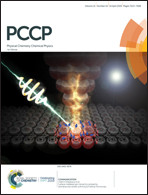Enhanced photocatalysis for water splitting in layered tin chalcogenides with high carrier mobility†
Abstract
Due to their proper band gaps (between 1.40 eV and 2.34 eV), newly fabricated tin monochalcogenides (SnX, X = S, Se) and dichalcogenides SnX2, whose monolayer formation energies are much smaller than MoS2, are promising materials for harvesting visible light. Moreover, the anisotropic carrier mobility is up to 2486.93 cm2 V−1 s−1 for SnSe and 2181.96 cm2 V−1 s−1 for SnS2. By applying low tensile strain, the band edge of SnX can be lowered to meet the criteria for water splitting. Meanwhile, the photo-generated exciton binding energies are pretty low, which indicates that the electron–hole can separate efficiently, and may lead to remarkable activity for photocatalysis. Promisingly, it is possible to stack SnS and SnS2 to fabricate a vertical heterostructure (VHT). According to band analysis, we found that the global valence and conduction bands are from SnX and SnX2, respectively. Due to the weak interaction between the two monolayers, the optical gaps can slightly decrease in the two monolayers compared to those in the corresponding isolated ones. Therefore, the VHT can meet the two primary conditions of a photocatalyst for water splitting to generate H2 in SnX and O2 in SnX2. The strong electronegativity difference between the two layers develops an effective potential gradient between the SnS and SnS2 layers, which evokes an effective electric field between them. Thus, it is of benefit for quick charge separation and inter-layer charge transfer. High efficiency of light harvesting can be realized, and improved photocatalytic efficiency.



 Please wait while we load your content...
Please wait while we load your content...